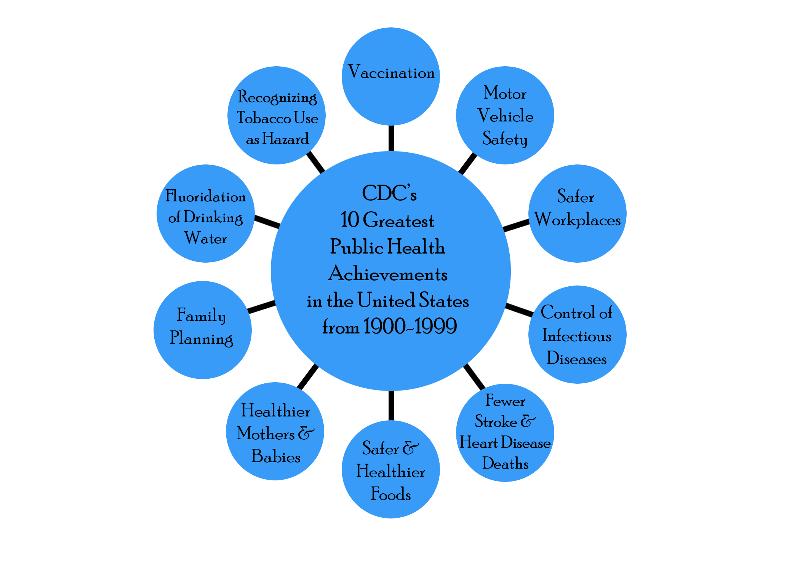1. What is Public Health?
What is health? What is public health?
The World Health Organization (WHO) defines health as:
"...a state of complete physical, mental, and social well-being; not merely the absence of disease or infirmity."
The Institute of Medicine (IOM) defines public health as:
"...what we, as a society do collectively to assure the conditions for people to be healthy."
As you learn about the role and goals of public health from the recordings in this training, think about how these definitions can assist and guide you in your work of being health and wellness leaders in your community.
After completing this section, you will be able to:
- Define key terms such as health, public health, and health equity
- Identify what is responsible for increased life expectancy in the US in the 20th century
- Compare two conceptual frameworks that guide public health
- Explain the mismatch in the US between what produces health versus what we spend on it
- Describe how human rights are inextricable from the health of the public
Recording 1A
For this video, and the subsequent ones in this training, select the arrow in the center of the screen or in the bottom right corner to play it. You can navigate forward/backward in the narration by using the menu, which can be accessed via the three horizontal bars in the top left corner of the screen. A transcript is available by selecting "Resources" in the top right corner of the screen.
Listen to the following recording (approximately 10 minutes).
Action Item
Addressing Chronic Health Conditions in Your Community
As discussed in the video, depression and obesity are pressing public health concerns.
- What is being done in your community to address depression?
- Is your community connected to Mass in Motion, working to address obesity?
Refer to the last page of this training to access these and other public health resources:
- MA Department of Mental Health, with many resources for mental health on their website
- Mass in Motion, a statewide movement that promotes opportunities for healthy eating and active living in the places people live, learn, work and play
Remember, the core role of public health is to create a healthy world. Always be mindful of ways in which you can get more involved in combating important public health challenges in your community.
Recording 1B
Listen to this recording (approximately 15 minutes).
Action Item
This image lists the CDC's 10 Greatest Public Health Achievements from the 20th Century. Think about what current and future public health efforts might make the list of greatest public health achievements over the next 100 years.

Recording 1C
Listen to this recording (approximately 20 minutes).
Action Item
Defining Health Equity
How do you define health equity? How do you address health equity in your daily public health work?
For some best practices and practice-based strategies to incorporate equity into foundational skills of public health and to advance health equity in your community, review the CDC publication A Practitioner's Guide for Advancing Health Equity: Community Strategies for Preventing Chronic Disease.
According to the Guide, health equity means that every person has an opportunity to achieve optimal health regardless of:
- The color of their skin
- The level of education they've received
- Their gender identity
- Their sexual orientation
- The job they have
- The neighborhood they live in
- Whether or not they have a disability
Recording 1D
Listen to this recording (approximately 12 minutes).
Action Item
 Review your community's most recent annual report, especially the sections that the Board of Health adds and the budget section. If you're not sure where to find it, ask your Town or City Clerk.
Review your community's most recent annual report, especially the sections that the Board of Health adds and the budget section. If you're not sure where to find it, ask your Town or City Clerk.
Compare the annual budgets for town/city departments (i.e., school, fire, police, recreation/parks) to the annual budget for public health.
In your opinion, is your community prioritizing public health? If not, consider ways you might be able to educate community leaders and residents about the value of public health.
Recording 1E
Listen to this recording (approximately 15 minutes).
Action Item
Collaboration in Your Community
Are there health issues or certain populations in your community that require collaboration in order to shift the prevalence vs. risk factor curve "to the left" as described in the recording?
Using students as your population of interest, consider how you could collaborate with your school department.
- You could reach out to the school nurses in your district to understand health concerns that they may have already identified in the student population
- Remember, school nurses are public health nurses who happen to work in a school setting
Of course, there are many other potential collaborators who are concerned about youth. Getting to know your community will help you identify them.
We need many partners to achieve our mission of creating healthier communities and a healthier world.